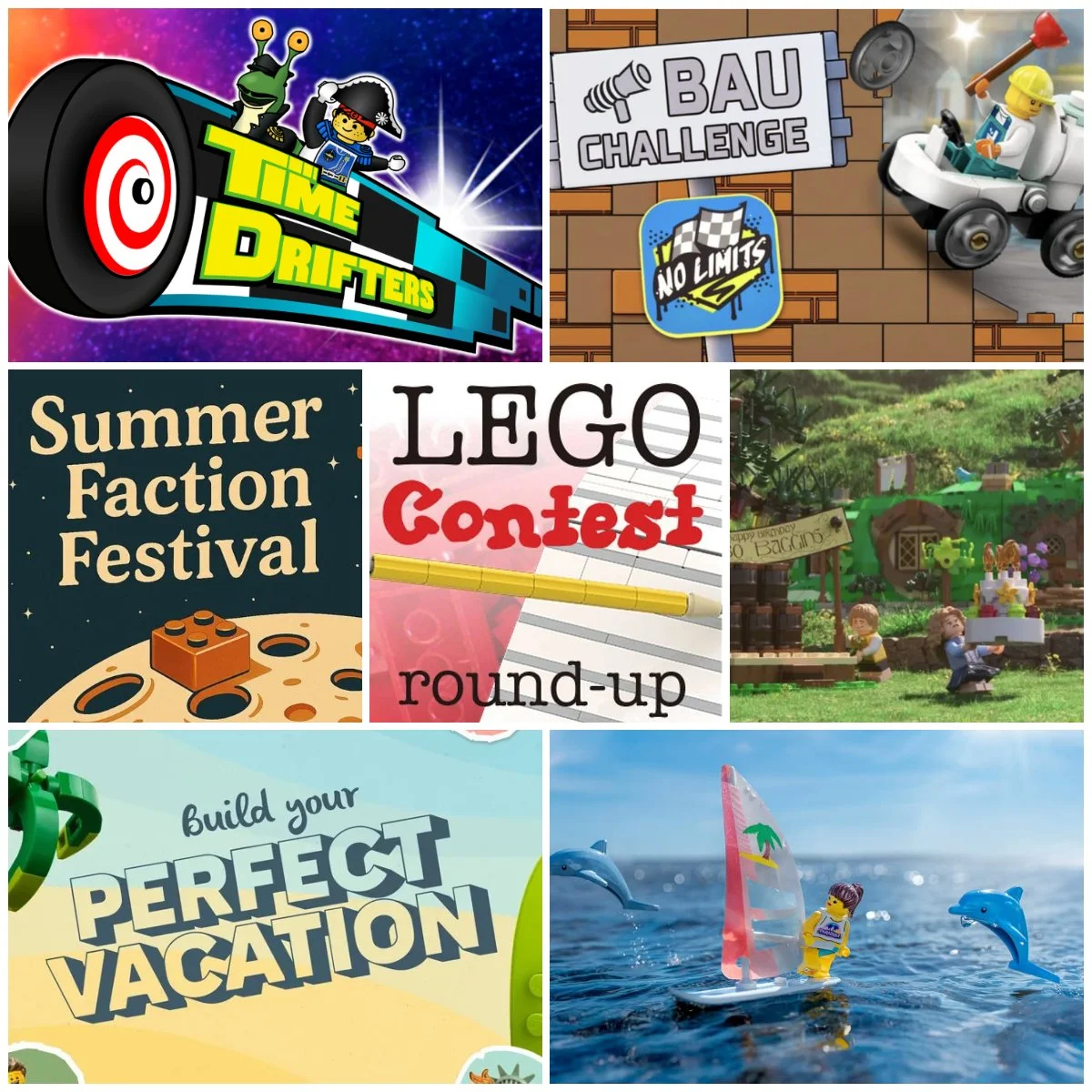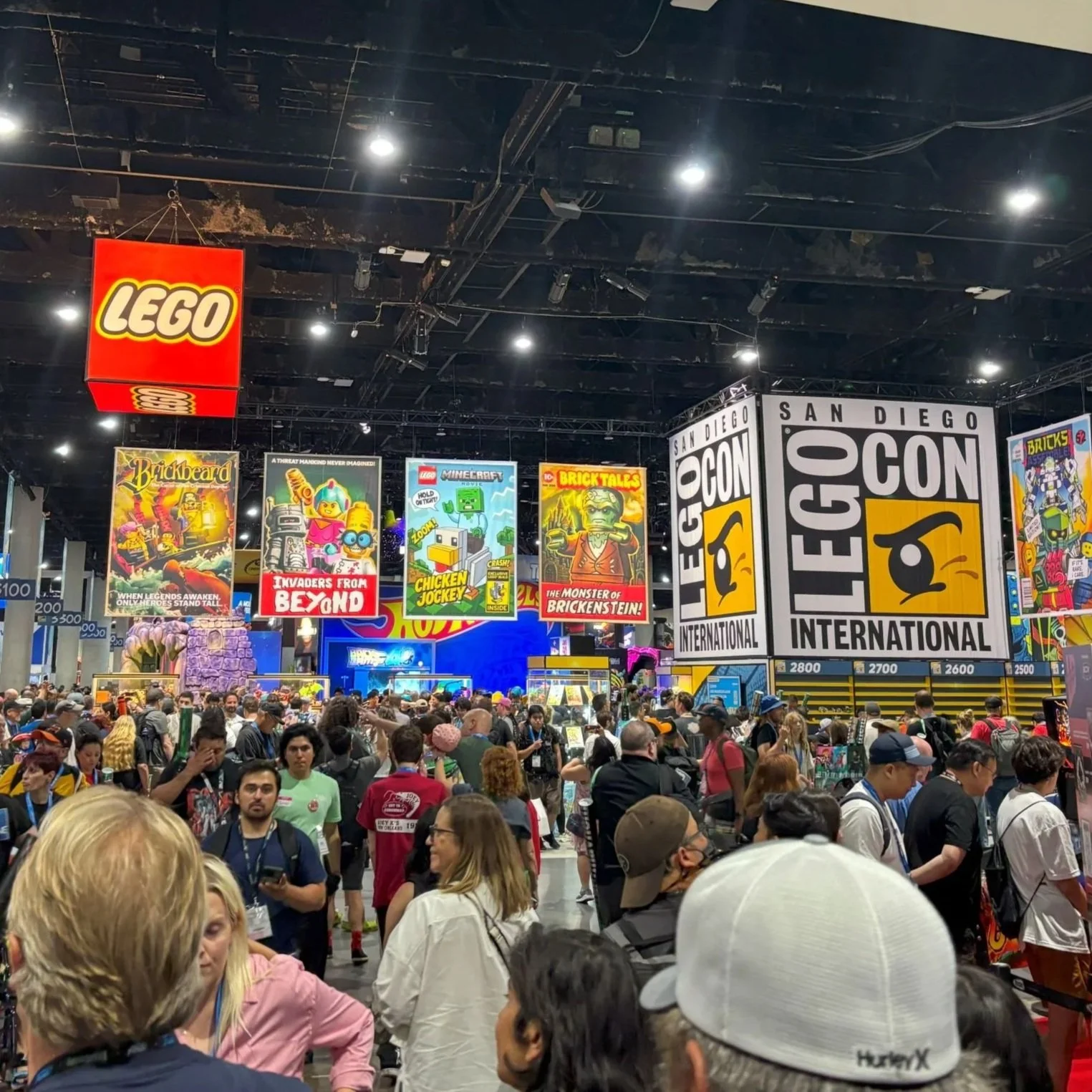The Life Aquatic with Ken Ito 暁工房
/While many of us around the world are sweltering in the summer heat, I thought it would be a perfect time to dive back into the deep end of the LEGO Flickr group photo pool to cool off. Swimming around, I was startled by seeing an “old school” AFOL builder breaching the surface once again with some of his killer builds. That builder is Ken Ito / 暁工房, based in Tokyo, Japan.
I say “old school” as I was looking back through his photostream and I saw some of his builds that I had faved waaaaay back in 2010. Namely this cute little black-and-tan dachshund. He also built some killer dinosaur builds that still stand the test of time. The “killer builds” we are here to enjoy today, however, are killer whales (orcas), along with bottlenose dolphins and penguins. Ecologically speaking, plastic and aquatic animals are not a good combination. However, I think you will agree that Ken’s builds prove to be the exception to the rule. The sleek, organic shaping he has achieved is nothing short of phenomenal.
Now you may be saying to yourself, “I am sure I have seen Ken post these builds before. Has Ted been living under a rock?”… and you are probably right (on both counts). However, if you take a much closer look, you will see that Ken takes a Kaizen (改善, かいぜん) approach to building his MOCs. Whereas most of us would have been perfectly satisfied having created one of his earlier iterations, Ken continues to refine the shaping of his builds with incremental improvements.
I think a Bonsai tree artist might take a similar approach, especially needing attention as the tree continues to grow and change through the seasons. In LEGO MOC building and Bonsai art alike, the ultimate goal for many is “a masterpiece composition that seems natural, without artifice or affectation.”
I reached out to Ken to learn more about his approach to building these curvaceous cetaceans, and what else he has been up to lately. Special thanks to Christopher Hoffmann for all the support in helping us to provide an English-Japanese translation of this interview (especially in the midst of a typhoon - Stay safe!).
An Interview with Ken Ito 暁工房
Ted Andes: Hello Ito-san! I noticed that you posted some new photographs of your orca and dolphin MOCs on Flickr. That made me curious about your approach to MOC building, and what else you have been doing lately. May I ask you a few questions? / Ted Andes: Itoさん、こんにちは。シャチとイルカの新しい写真をアップしましたよね。それを見てItoさんの創作アプローチや次のプロジェクトについて興味を持たされました。少し質問してもいいですか?
Ken Ito 暁工房: Thank you for your message. I would be happy to answer what questions you have. / Ken Ito: メッセージありがとうございます。喜んで質問に答えます。
Ted: First, I noticed that you created your Flickr account in 2009. How long had you been building with LEGO before that? / Ted: ありがとうございます。まず、2009年にFlickrに登録しましたよね。その前にどれぐらいレゴをやってたんですか?
Ken: I have been building with LEGO since childhood, although like many others I did have a LEGO dark age. I restarted building with LEGO in 1999. / Ito: 子供の頃からやっていますが、多くの大人ファンと同様、大きくなったら一旦レゴから離れた時もありました。そして1999年にまたレゴを始めました。
Ted: Do you share photographs of your LEGO builds in other places besides on Flickr? / Ted: Flickr意外のサイトを利用してレゴ作品をアップしますか?
Ken: I sometimes share my WIPs on Facebook and Twitter, but I mainly share on Flickr. / Ito: 時々Facebookやツイッターに制作中をシェアしますが、Flickrがメインですね。
Ted: So, what has drawn you specifically towards building animal creations? / Ted: 特に生き物に惹かれているのは何ですか?
Ken: It is because I cannot build robots and spaceships like yours. LOL. Mainly, it is because I enjoy the challenge of creating animal shapes, while also conveying the sense of their beautiful movement. / Ito: なぜって私にはTedさんや皆さんのようにロボットや宇宙船が作れませんから(笑)。主に生き物の美しさや動きが感じられる形に挑戦するのが楽しいです。
Ted: Well, I don’t think I could build animals like yours, so the admiration is mutual. What is your process for coming up with the shaping for them? Where do you begin? / Ted: こちらこそItoさん程の生き物は作れませんよ。そこはおあいこですね。ではその造形方法をもっと詳しく説明してくれますか? どこから始めますか?
国立科学博物館のシャチです。/ Orca skeleton at the National Museum of Science.
Ken: I typically start with a concept in my mind, and then I “build in my brain.” After that, I simply try putting it together in various ways with actual bricks.
For reference materials, I usually work from photos, movies and figure models. What I really value the most as a reference for animal models are images of their actual skeletal structure. I find that is the most important reference material for me in the shaping. / Ito: まずコンセプトから始めます。それから頭の中で組み立て方を考えて、次に実際にブロックを使って試します。参考資料として写真や動画、フィギュアを見ます。生き物作品に一番役立つのは骨格です。造形にはもっとも大切な参考資料ですね。
Ted: I would not have thought of the importance of that, considering that the skeletons themselves aren’t ever seen in the MOC. When you are actually putting the bricks together, what is your approach? Do you start by defining the side-view profile first, or some other way? / Ted: へ~、作品に骨格が見えませんからそんなに大切なのかは思ってもみなかったですね!そしたらレゴでどうやって表現しますか?側面から見るのか、また違う方法ですか?
Ken: I make the head first, and then from there always start with building the left side. Then on the right side, I try shaping it in another way from how I built the left side, and then I compare it to see which I like better. / Ito: まず頭から作ります。それからいつも左側から始めます。左側ができたら右側を違う方法で造形してみて、左側と比べます。
Ted: Fascinating! I see that you also take a continuous improvement approach to your MOCs that most people might otherwise think have been complete. I would compare your approach to a Bonsai artist in that way, always trying to achieve that “natural perfection.” Is that a fair comparison? / Ted: 面白いアプローチですね。また気付いたのは、すでに完成したような作品でももう一回作り直して、だんだん改善し続けますよね。私から見ると、Itoさんの作品は盆栽のようにいつも「自然のままの完成へ」という目的を狙っているようです。そういう比較をどう思いますか?
Ken: That’s very interesting! I’ve even thought about that myself. To tell the truth, I’m more like a Japanese traditional garden landscaper than a Bonsai artist. However, the common spirit of them is “as time goes by,” I think. My LEGO creations don’t reach such lofty ideals, but I think it’s a shame to say “Well it’s finished now, so on to the next thing.” And with using LEGO, the opportunity for change is always there. / Ito: とても面白い比較ですね!自分自身はそんな風に考えたことはありませんでした。実は盆栽家ではありませんが私は造園の技術者なんです。盆栽と日本の伝統的な庭園とでは「時はうつろう」という精神は共通していますね。私のレゴはそこまで高尚なものではありませんが、「完成したらそれで終わり」で次の作品へ移ってしまってはちょっともったいないと思います。レゴは何度でも作り直せますから。
Ted: Can you describe some of those changes you have made over time to the orca and dolphin? / Ted: シャチとイルカについて、最初の完成から今までに作り直したところを具体的に紹介してくれませんか?
Ken: Sure. For the orca, I have been focused on the 1) head, 2) body length & height, and 3) shape of flippers. / Ito: はい。シャチは頭と体長、そして鰭の形を変えました。
For the Dolphin, it has been the 1) head, 2) body length, and 3) position of flippers. Back in March 2020, you will see that I changed the color of the torso and fixed the details a bit. / イルカは頭と体長、そして鰭の位置です。2020年3月には胴体の色を変えてこまかいところを調整しました。
Ted: I think I know the answer to this, but do you now feel satisfied with their designs at this stage, or are there still areas that you want to continually improve on them? / Ted: 聞くまでもないと思いますけど、今のデザインは満足ですか?それとも改善したいところがまだ残っていますか?
Ken: No, I’m not satisfied. Making heads smaller is a very difficult challenge to me, so I think that it is not over. It is still is very interesting to me to investigate further, as new LEGO parts become available.
I also want to build new water bases for them that help express their motion better. For the base of the dolphin, I was originally making a wave pattern with a curve slope, but I happened to like the long tiles on the top of the arches. It reminded me of logos on running shoes (that always may you feel like you can run faster). As you can see with my recent update to the orca breaching the water, I am interested in creating interesting stands that help convey the beautiful movement even further. / Ito: やっぱり不満ですね。今の挑戦は頭を小さくすること。そこがまだまだですね。新しいパーツがどんどん増えていくから楽しみにしています。動きをよりよく表すために新しい水上ベースも作りたいです。イルカのベースに元々カーブスロープを使ってみましたが、アーチの上に載せた長いタイルの方が気になりました。ランニングシューズの早く走れる気を表すマークを思い出しますね。ブリーチングするシャチの作品で見せたように、更に美しい動きを表すスタンドを取り組んでいます。
Ted: Are you working on refining any of your other animal designs? / Ted: 他の生き物作品にもさらに手を加えていますか?
Ken: Yes. I have been refining my my Apatosaurus. As you may know, ′′dinosaur′′ means “horrible lizard” but in Japanese, it is written as “dragon.” On the Apatosaurus, I felt that the neck was too long, so I have shortened that, and on the other hand, the limbs that I felt were too short I elongated. Also, the neck and shoulder blades are now even more muscular. / Ito: はい、最近アパトサウルスに手を入れています。英語の「dinosaur」は「恐ろしいトカゲ」という意味だけど、日本語では「恐ろしい竜」の字で書かれます。前のアパトサウルスの首が長すぎると思ったので短くしました。一方、足が短すぎると思ってそれらを伸ばしました。また、首と肩をがっちりさせました。
Ted: Do you have any plans to build any completely new animal designs? / Ted: 別の新しい生き物作品も考えているでしょうか?
Ken: Yes. I still want to build other types of cetaceans, and new monsters as well. / Ito: はい、別の種類のクジラ目やモンスターを構想しています。
Ted: As always, I will be patiently looking forward to seeing them. Thank you so much for sharing, Ito-san! 有難うございます。/ Ted: いつも通り楽しみにしてお待ちしております。今日色々見せてくれてありがとうございます。
Ken: Thank you again for reaching out. / Ito: 声を掛けてくれてありがとうございます。
And after all of that, I completed forgot to ask Ken about his penguins, but perhaps they can speak for themselves… Enjoy!
せっかくだったのにペンギンについて質問するのをすっかり忘れてしまいました!でも素敵な作品だから自ら語るはずです。是非ご覧ください。
Have you ever revisited building a MOC multiple times? Let us know in the comment section below.
Do you want to help BrickNerd continue publishing articles like this one? Become a patron like Charlie Stephens, Marc & Liz Puleo and Paige Mueller to show your support, get early access, exclusive swag and more.




































